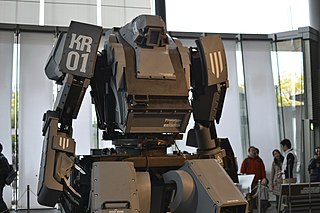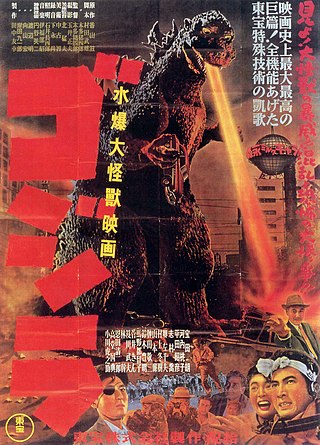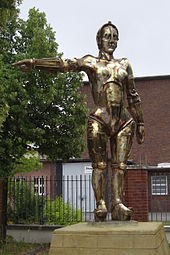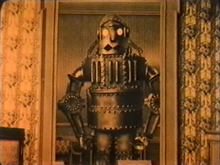
In science fiction, mecha or mechs are giant robots or machines typically depicted as piloted and as humanoid walking vehicles. The term was first used in Japanese after shortening the English loanword 'mechanism' or 'mechanical', but the meaning in Japanese is more inclusive, and 'robot' or 'giant robot' is the narrower term.

Science fiction is a film genre that uses speculative, fictional science-based depictions of phenomena that are not fully accepted by mainstream science, such as extraterrestrial lifeforms, spacecraft, robots, cyborgs, mutants, interstellar travel, time travel, or other technologies. Science fiction films have often been used to focus on political or social issues, and to explore philosophical issues like the human condition.

Power Rangers in Space is a television series and the sixth season of the Power Rangers franchise, based on the 21st Super Sentai series Denji Sentai Megaranger.

Tokusatsu is a Japanese term for live-action films or television programs that make heavy use of practical special effects. Credited to special effects director Eiji Tsuburaya, tokusatsu mainly refers to science fiction, war, fantasy, or horror media featuring such technology but is also occasionally dubbed a genre itself. Its contemporary use originated in the Japanese mass media around 1958 to explain special effects in an easy-to-understand manner and was popularized during the "first monster boom" (1966-1968). Prior to the monster boom, it was known in Japan as Tokushu gijutsu or shortened Tokugi.
A robot is a virtual or mechanical artificial agent, usually an electro-mechanical machine.
The Metal Hero Series is a metaseries of tokusatsu superhero TV series produced by Toei for Japanese television.

Machine Robo: Revenge of Cronos, known in France as La Revanche des GoBots, is a Japanese anime television series produced by Ashi Productions. It ran on TV Tokyo from July 3, 1986, through May 28, 1987.

Spider-Man, also referred to as Japanese Spider-Man or Toei Spider-Man, is a Japanese live-action tokusatsu super hero television series produced by Toei Company, loosely based on Marvel Comics' character of the same name via a contract that was negotiated by producer Gene Pelc. The series lasted 41 episodes, which aired on Tokyo Channel 12 from May 17, 1978, to March 14, 1979. A theatrical episode was shown in the Toei Manga Matsuri film festival on July 22, 1978. From March 5 to December 24, 2009, Marvel uploaded English subtitled versions of all 41 episodes on their website.
Machine Robo: Battle Hackers is a Japanese animated television series produced by Ashi Productions. It ran on TV Tokyo from June 3, 1987 through December 30, 1987.

G-Force: Guardians of Space (1986) is the second American animated television adaptation of the Japanese anime series Science Ninja Team Gatchaman (1972), following Sandy Frank Entertainment's initial 1978 effort Battle of the Planets and preceding ADV Films' 2005 attempt, known merely as Gatchaman. With G-Force, Sandy Frank Entertainment collaborated with Turner Broadcasting to create a newer, more faithful translation of Science Ninja Team Gatchaman for a new audience, and such a translation was made possible with the relaxed television standards of the 1980s, a luxury that the more Star Wars-themed Battle of the Planets did not enjoy.
Robotics is the branch of technology that deals with the design, construction, operation, structural disposition, manufacture and application of robots. Robotics is related to the sciences of electronics, engineering, mechanics, and software. The word "robot" was introduced to the public by Czech writer Karel Čapek in his play R.U.R., published in 1920. The term "robotics" was coined by Isaac Asimov in his 1941 science fiction short-story "Liar!"
The following outline is provided as an overview of and topical guide to robotics:

Randy Cunningham: 9th Grade Ninja is an animated television series created by Jed Elinoff and Scott Thomas for Disney XD. It was produced by Titmouse, Inc. and Boulder Media Limited for Disney's London-based content hub. Many of the character designs were supplied by Jhonen Vasquez, the creator of Invader Zim. The first episode premiered on Disney XD on August 13, 2012, and the final episode premiered on July 27, 2015. Voice direction for the series was done by Ginny McSwain. Shaun Cashman was the supervising director.
This page is based on this
Wikipedia article Text is available under the
CC BY-SA 4.0 license; additional terms may apply.
Images, videos and audio are available under their respective licenses.









